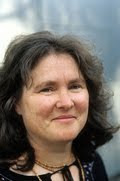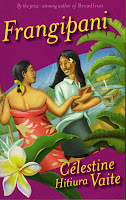Last week Resurrection, the third book in the Blood of the Lamb trilogy, was released. I interviewed Mandy Hager recently about the series and her writing process.
 |
| Mandy Hager |
1. How did the idea for the Blood of the Lamb series come about?
It seems weird now to answer this, as the books are a long way from the original idea! But the germ of the idea came from being a vegetarian! I was thinking about the way we treat animals – especially small farm holders – who raise animals with great love and warmth, yet eventually go on to kill and eat them! I was thinking how if you transferred this same kind of exploitative behaviour to children instead of other animals it would seem horrendous... and the book idea started growing from there! Also, I’d worked for 3 years as a writing mentor for a man who was a member of a Fijian cargo cult, and this got me thinking about the religious side of things, and how such a cult could develop.
2. Did you originally pitch a series or was it at the publisher’s suggestion?
I had been thinking about this theme for a long time and had done quite a lot of research but wanted to walk around a cruise ship (I’m a very visual person and like to be able to explore settings etc so I can get a real feel for them) but couldn’t get on one because after Sept 11th security was so tight they wouldn’t let anybody on unless they were paying passengers! So I put the idea on hold. Later, my publisher jokingly asked if I had an idea that would suit a trilogy – I went home and started thinking about this old idea and realised it had enough story to be broken into 3 books. Luckily, by then I managed to wangle my way onto a cruise ship to look around!
3. The Crossing strongly portrayed a Gilbertese setting. Have you a Kiribati connection?
No I don’t. But I worked for an organisation for 3 years who did a lot of work with Pacific Island development, so I knew a little about the issues facing many of the Pacific Islands, including issues of colonisation and climate change. At the time I started writing it I spent 3 weeks in Fiji – the first time I’d been to a Pacific Island other than Aotearoa – and this helped me to imagine the world I was creating. Also, I did a LOT of research!
4. Do you work from a plan or develop the plot as you write a novel? What is your typical writing day?
Yes, I definitely plan – I strongly believe in this for me – I feel that knowing the structure of a book gives it drive and impels the reader through the story. I always know the main plot points before I start – but not how I’m going to get between each one – that’s the bit you have to trust to the magic of creativity – and it always throws up things I’d never have been able to plan in advance! When I’m working on a book I spend quite a lot of time making notes, doing research and planning, and getting to understand characters before I start. Once I start I try to write a chapter a week – write in the mornings and through to about 2 or 3pm, then print off and revise.
5. Politics and religion are fair game in this series. Did you mean to be so controversial?
Not sure that I’d say I mean to be controversial – but I’m not scared of it! I come from a politically active family, so I guess it’s not surprising. I see things that really worry me about the world and figure that the only way I have any power to try and make things better is to express that worry and to encourage people to look a little harder at the causes and effects. I know the books will probably offend some people – but suspect that if they’re offended they have possibly heard about them but not read them! Because the books really just advocate for fairness, human rights, compassion and love – and how could anyone object to that?! I’m not attacking people’s right to believe in a higher power – but I do believe that everyone has the right to make up their own minds and not be controlled by the institutions who have set themselves up around this. We only have to look at what’s happening today to see the destructive force of using religion to suppress those who don’t do as they’re told by the people in control, and as a means of trying to oppress anyone who thinks differently.
6. Can you give us an outline of Maryam’s adventures in the third book of the series, Resurrection.
I don’t want to give the plot away – but let’s just say Maryam faces her most challenging situation yet... and that she returns to Onewēre, and that it gets very scary!
7. Why do you write for young adults?
I really like young adults and respect them – I want to speak to them honestly and say ‘hey – have you thought about things in this way?’ I have 2 children aged 25 and 22 – it terrifies me that they’re growing up in such uncertain times and I try to do everything I can to promote change for a better world. I write for young adults because it’s really important they think about what’s going on and are able to access lots of different points of view about what’s going on – not just the propaganda and rubbish they get fed in mainstream media. I want to try and activate them to ask the hard questions and demand better behaviour and morals from those in power.
8. What are your favourite island stories?
Sadly there were not many island stories around when I was young, so I’d have to say Swiss Family Robinson and I remember a book I really loved by Armstrong Sperry called ‘The Boy Who Was Afraid.’ More recently, I’ve really enjoyed Lloyd Jones’s Mr Pip and books by Albert Wendt.
9. If you could visit any island in the world, where would you choose?
Although I’d love to visit more Pacific Islands I’d have to say Zanzibar, off the coast of East Africa. This was where my mother was born, and she loved it so dearly I’d love to go there and experience it for myself.








































